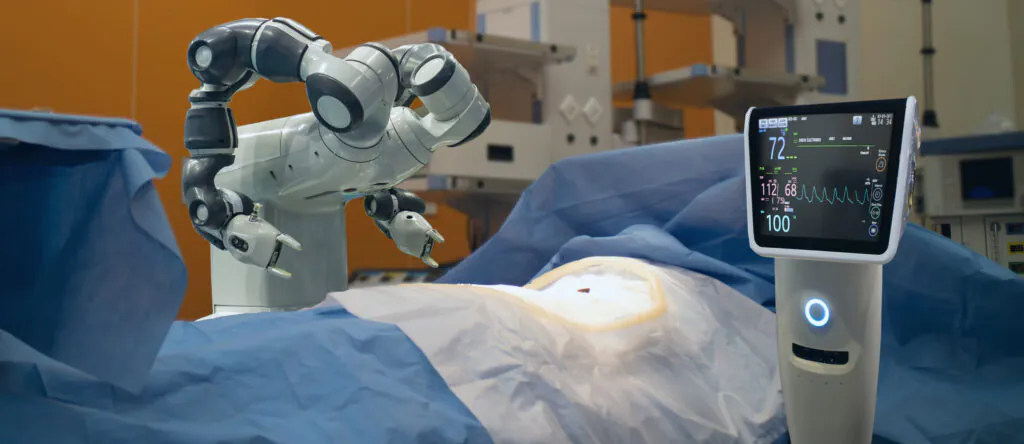Overview
The medical robotics market is experiencing rapid growth driven by technological advancements, increasing demand for minimally invasive procedures, and a focus on improving patient outcomes. Robotics in healthcare is revolutionizing medical care by introducing advanced technologies that enhance precision, efficiency, and patient outcomes. From robotic-assisted surgeries that allow for minimally invasive procedures to automated systems that streamline diagnostics and patient monitoring, robotics is transforming the way healthcare is delivered. These innovations not only reduce recovery times and improve surgical accuracy but also alleviate the workload on medical professionals, enabling them to focus on more complex patient care tasks. The integration of robotics in rehabilitation, prosthetics, and elderly care further demonstrates its potential to improve the quality of life for patients. As robotics continues to evolve, its role in healthcare is expected to expand, driving significant advancements in medical treatment and patient management.

Types of Medical Robotics and Their Applications
Medical robotics are increasingly diverse, each designed to address specific needs within the healthcare sector, offering innovative solutions that significantly enhance patient care and medical efficiency.
Surgical Robotics
Surgical robotics, like the da Vinci Surgical System, utilize AI to assist surgeons in performing minimally invasive procedures with exceptional precision, resulting in quicker recovery times and improved patient outcomes. These robotics are expanding into specialized fields such as orthopedics, neurosurgery, and gynecology, demonstrating their versatility.
Rehabilitation Robotics
Rehabilitation robotics offer AI-driven personalized therapy, adapting in real-time to a patient's progress and enhancing recovery outcomes. Devices like robotic exoskeletons support patients in relearning movement, providing both safety and encouragement throughout the rehabilitation process.
Diagnostic Robotics
Diagnostic robotics, equipped with AI, enhance the accuracy of medical imaging and early disease detection by navigating complex anatomy with precision. They are increasingly used in procedures like automated biopsies, improving diagnostic confidence and reducing the need for repeat procedures.
Telepresence Robotics
Telepresence robots enable healthcare providers to offer remote consultations and care, particularly benefiting patients in isolated or underserved areas. These robotics also assist with remote monitoring, reducing the need for physical presence while maintaining high-quality care.
Pharmacy and Healthcare Automation Robotics
Pharmacy and healthcare automation robots manage medication dispensing with AI-enhanced precision, reducing errors and optimizing efficiency in hospital pharmacies. They streamline operations, allowing pharmacists to focus on patient care and improving overall medication management.
Robotic Prosthetics
Robotic prosthetics are advancing with neural interface technology, allowing them to mimic natural limb movements and respond to brain signals, providing greater dexterity and control for users. Sensory feedback systems are also being developed, enabling users to experience sensations like pressure and temperature, enhancing the connection between humans and machines.
Benefits of Using Robotics in Healthcare
The integration of medical robot technology in healthcare offers numerous benefits that significantly enhance the quality of care and operational efficiency.
- Precision and accuracy in surgical procedures are greatly improved with the help of AI-enhanced robotic systems, leading to fewer complications, less trauma to patients, and faster recovery times
- Increased efficiency in medical processes, including diagnostics and medication management, is achieved through the automation of routine tasks, reducing human error and allowing healthcare providers to focus on more complex patient care activities
- Enhanced access to care through telepresence and remote robotic systems has become crucial, particularly in providing expert medical consultation and care to patients in remote or underserved areas
- The rise of personalized rehabilitation through AI-driven robotic therapy ensures that patients receive consistent, adaptive treatment that evolves with their progress
- Robotics also plays a key role in addressing workforce shortages by automating routine tasks, thereby enabling healthcare professionals to concentrate on critical patient-centric duties
The overall use of robotics in healthcare contributes to improved patient outcomes, operational efficiency, and accessibility, making it an indispensable tool in modern medical care.
Challenges in Using Medical Robotics
Despite the many benefits, the implementation of robotics in healthcare presents several challenges and considerations that must be addressed.
- High costs associated with acquiring, maintaining, and upgrading advanced robotic systems can be prohibitive, particularly for smaller healthcare facilities or those in low-resource settings
- Training and integration of medical staff with these technologies require significant investment in education and time, which can slow the adoption of robotic systems.
- Ethical and legal concerns regarding the use of robots in critical areas like surgery and patient interaction raise questions about liability, patient consent, and the delegation of decision-making to machines
- Data security is a critical issue, as the integration of robotics with healthcare systems often involves handling vast amounts of sensitive patient information, necessitating robust cybersecurity measures to protect against breaches
- Technological limitations, such as the potential for system malfunctions or software errors, can pose significant risks to patient safety, requiring continuous monitoring and maintenance
- Additionally, there is ongoing debate over the impact of robotics on the healthcare workforce, with concerns about job displacement and the need for new skill sets
Addressing these challenges requires a comprehensive approach, including regulatory frameworks, ongoing training, and investment in secure and reliable robotic systems.
Future Trends in Healthcare Robotics
-
AI-Powered Robots in Diagnostics and TreatmentAI-enabled robots will enhance diagnostics by providing more accurate and early disease detection, while also taking on autonomous roles in surgeries and treatment planning. These advancements will lead to highly personalized and effective medical care.
-
Wearable Robotics and ExoskeletonsWearable robotic devices and exoskeletons will become essential in rehabilitation and elderly care, improving mobility and independence. Advances in design will make these devices more comfortable and suitable for daily use, enhancing the patient’s quality of life.
-
Collaborative Robots (Cobots)Cobots will increasingly assist healthcare professionals with routine tasks and complex procedures, improving efficiency and reducing physical strain. AI-driven cobots will continuously learn from human colleagues, enhancing their performance over time.
-
Miniaturization of Medical RobotsThe miniaturization of medical robots will enable their use in delicate procedures like microsurgeries and targeted drug delivery, making treatments less invasive. These advancements will open new possibilities for precise medical interventions at the cellular level.
-
Telemedicine and Robotics IntegrationTelemedicine will expand with robotic support, allowing remote access to specialized care and real-time patient monitoring. This integration will improve healthcare accessibility, particularly in underserved areas, and extend the reach of tele-rehabilitation.
-
Advancements in Surgical RoboticsNext-generation surgical robots will offer improved dexterity and AI-driven support, making minimally invasive techniques more accessible. The development of fully autonomous surgical systems will push the boundaries of what is possible in modern surgery innovations.
-
Ethical and Regulatory EvolutionThe rise of healthcare robotics will necessitate new ethical guidelines and regulatory frameworks to ensure safety and data privacy. Collaboration between technologists, healthcare providers, and policymakers will be crucial in addressing these challenges.
Real-World Examples of Medical Robotics
Here are some real-world examples of medical robotics and their application in healthcare:
| Company | Robotic System | Application in Healthcare |
| Intuitive Surgical | da Vinci Surgical System | Used for minimally invasive surgeries across various specialties such as urology, gynecology, and cardiothoracic procedures. The system provides enhanced precision, reduced blood loss, and quicker recovery times for patients. |
| Globus Medical | ExcelsiusGPS | A robotic navigation platform is employed in spine surgeries to improve the accuracy of implant placement. It combines real-time imaging with robotic assistance, reducing the risk of complications and enhancing surgical outcomes. |
| Stryker | Mako Robotic-Arm Assisted Surgery | Assists in orthopedic surgeries, including knee and hip replacements, by providing precise planning and execution of surgical cuts. This leads to better implant positioning, improved joint function, and faster patient recovery. |
| Accuray | CyberKnife System | A robotic radiosurgery system is used to deliver high doses of radiation with sub-millimeter accuracy to treat tumors in the brain, spine, lungs, and other areas. It minimizes damage to surrounding healthy tissue while effectively targeting cancerous growths. |
| Aethon | TUG Robots | Autonomous mobile robots are designed to transport medications, lab specimens, and other materials within hospitals. They help streamline hospital logistics, reduce staff workload, and improve efficiency in the healthcare setting. |
| PARO Robots | PARO Therapeutic Robot | A robotic seal is used in therapeutic settings to provide emotional support and comfort, particularly for patients with dementia. It helps reduce stress and anxiety, improving overall well-being and quality of life for elderly individuals. |
| ReWalk Robotics | ReWalk Exoskeleton | A wearable robotic suit that enables individuals with spinal cord injuries to stand, walk, and climb stairs. It provides powered hip and knee motion, facilitating mobility and improving the quality of life for users. |
| Iba Dosimetry | Dolphin | A robotic system is used for the real-time verification of radiation dose delivery in cancer treatments. It ensures that the radiation is accurately targeted to the tumor, enhancing the safety and effectiveness of radiation therapy. |
Conclusion
The integration of robotics into healthcare has marked a transformative shift in medical care, enhancing precision, efficiency, and overall patient outcomes. From the advanced capabilities of surgical robots like the da Vinci Surgical System to the life-changing impacts of rehabilitation robots and prosthetics, these technologies have revolutionized the way medical procedures are performed, and patients are cared for. Diagnostic robots with AI-driven imaging, telepresence robots for remote consultations, and pharmacy automation systems highlight the broad healthcare robot applications in improving accuracy and streamlining healthcare processes. Despite the promising benefits, challenges such as high costs, training needs, and ethical considerations must be addressed to ensure the effective and equitable use of these technologies. Looking forward, advancements in AI, miniaturization, and telemedicine integration will further expand the role of robotics in healthcare, offering even more personalized and efficient care solutions. As these innovations continue to evolve, they will play a crucial role in shaping the future of medical care and patient management.


